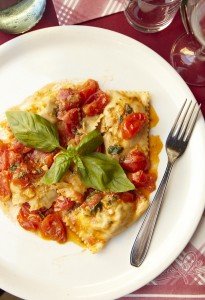Costa Rica's Favorite Meal: The Casado
February 7, 2025
Costa Rica is a fabulous destination for luxury travelers, as well as seniors, couples, and families, not least because of its many excellent dining options.…
Read This PostWe’re visiting one again with our favorite new chef, Andrea of our Living the Real Tuscan Dream cooking vacation in Italy. Andrea not only shares his recipes – he shares his passion for food and his knowledge as a food historian.

Andrea explains: “The Mediterranean Diet – the name says it all – originates in precisely those countries that face the Mediterranean basin. This model of nutrition was abandoned in the sixties, especially in wealthy countries with booming economies, because it was considered too poor and less inviting than other dietary patterns in vogue.”
See all our cooking vacations in Italy.
“In the early nineties, cholesterol was found to be the cause of some heart problems and the Mediterranean diet regained many consumers. In 2010 pasta was declared “an intangible heritage of humanity.” Fruit, grains, fish, meat, extra virgin olive oil and, of course, pasta. Who has never got excited in front of a big, steaming plate of spaghetti or tagliatelle, maybe with just a bit of grated cheese and extra virgin olive oil or with a tasty meat sauce?”
Browse our Tuscany culinary vacations.
Serves: 6
Prep time: 60 minutes
Cook time: 4 minutes
Cook method: Boil
Ingredients for the pasta and the sauce:
Italy’s ancient grains are of course different than in the Americas – but you can always use any high quality organic wheat flour.
 Instructions for the pasta:
Instructions for the pasta:
1. Mound the flour on a word board or counter and make a well in the middle. Break the eggs into the well and add a pinch of salt and a tablespoon of olive oil. With a wooden spoon start mixing the dough from the center slowly outwards. When the flour has absorbed all the eggs, mix for about five minutes.
2. Knead the dough and if it is too soft add a little flour. If it is too dry, add a bit of water. However, you have to knead it vigorously for at least five or six minutes, until it is smooth and supple. Shape it into a ball, wrap it in plastic wrap and refrigerate it for about one hour.
3. After this time cut the dough into pieces about the size of a small fist. Flour a rolling pin and the surface of the table and start rolling out the pieces of dough. It must be rolled out until it is very thin, and preferably rectangular in shape. Let it dry for at least ten minutes and at this point roll it up on the shorter side. Cut the dough according to the size of “tagliatelle” that best fits the sauce you have prepared. Let the tagliatelle dry for about one hour.
Read our interview with Chef Andrea.
As Andrea explains: “In traditional Tuscan cooking, there were always hens to lay the eggs, there was always flour in the house and bread was made throughout the year. Homemade pasta was not an impossible task. But there was not always meat, and in fact there was not always money to buy meat. This is when Tuscan women invented “Sugo Finto” – or Fake Sauce, since “sugo” by definition in Tuscany meant a sauce made with meat. The process for preparing it is the same as that of meat sauce, but instead of adding meat, you add tomatoes. The old, traditional recipes for meat sauces were made without tomatoes. It was Cristoforo Colombo who brought tomatoes to Europe from the New World and it was not until 1800 that tomatoes were used in the Old World.”
Learn more about Tuscan wines and our Tuscany wine tours.
Instructions to make the sauce
4. The first step is always making a good vegetable broth. In a large pot boil celery stalks, carrots, onions, potatoes and a bit of salt.
5. Then mince 1/3 of each of the following: celery stalks, carrots and onions. Our grandmothers did not have scales, this was their way of cooking, by ratios rather than weights. Pour extra virgin olive oil into a pan and sauté the minced vegetables. Next, take diced tomatoes, more or less the same amount as the minced vegetables, and put them in a bowl with a bit of salt. After about ten minutes drain them. In my experience this is a very important step because if we sauté the tomatoes before draining them, the sauce will have a much less intense flavor.
6. When the minced vegetables are browned, add the tomatoes. After about fifteen or twenty minutes, add a good shot of Chianti wine, salt, pepper, red pepper flakes, and continue cooking for about another twenty minutes. Add the vegetable broth a little at a time, when necessary. During the last ten minutes add a sprig of rosemary, which will give its unique flavor to the sauce.
Today more and more people are becoming vegetarians so this is a very tasty sauce with no meat that is perfect for them. Serve the dish with a generous sprinkling of grated pecorino cheese.
If you’d like to cook with Chef Andrea (and who wouldn’t?) you can Live the Real Tuscan Dream and stay at his lovely Tuscan property, gather eggs from his hens, pick vegetables from his garden, and learn the secrets of authentic Tuscan cuisine!
 Interested in more pasta recipes? Try these dishes from our cooking vacations in Italy:
Interested in more pasta recipes? Try these dishes from our cooking vacations in Italy:
By Peg Kern
Sign up to receive our newsletter, which includes travel tips, recipes, promotions, and information on our best culinary tours.
Find more photos, videos, food facts, and travel stories from The International Kitchen on Facebook, Instagram, Pinterest, Twitter, and YouTube.